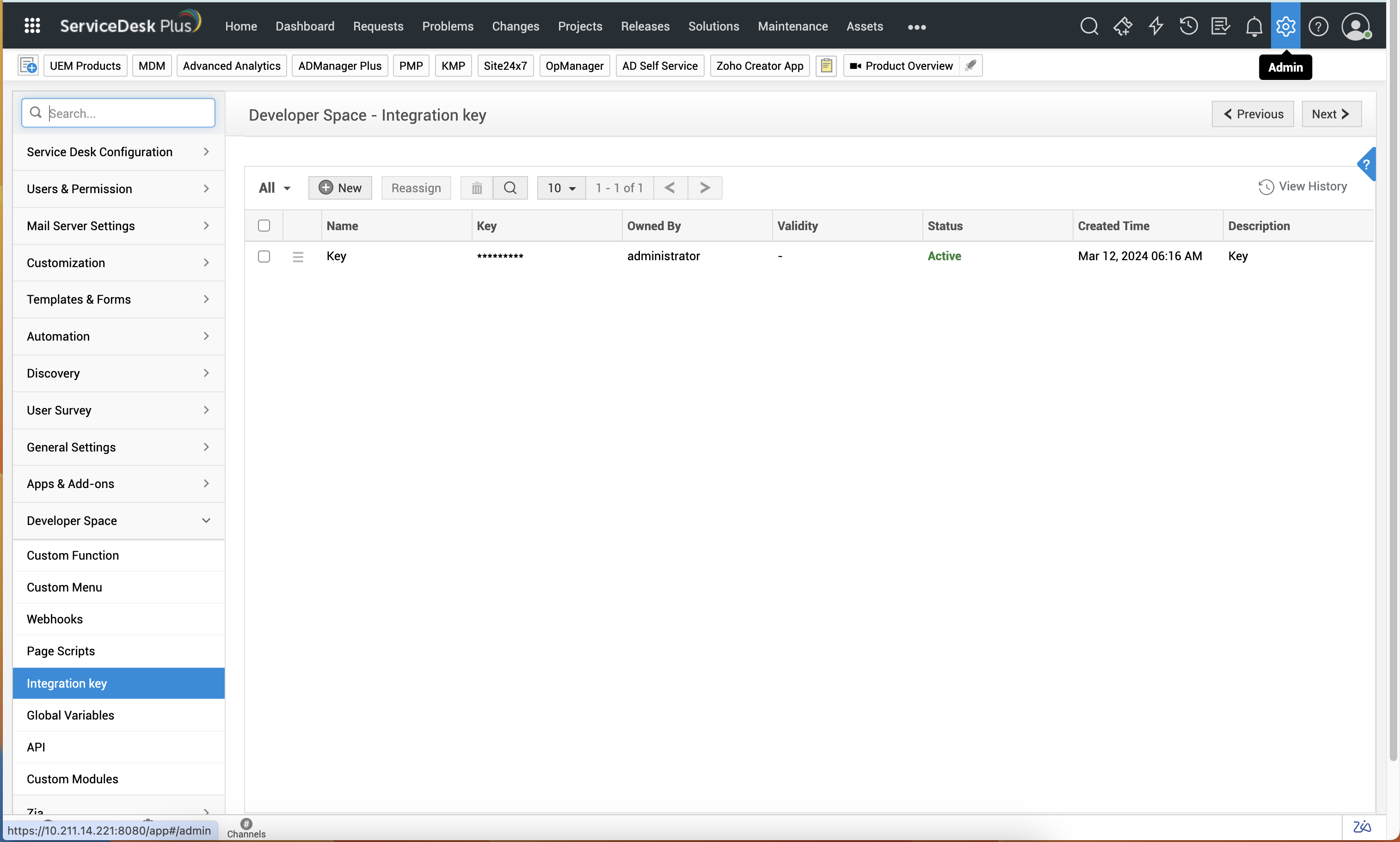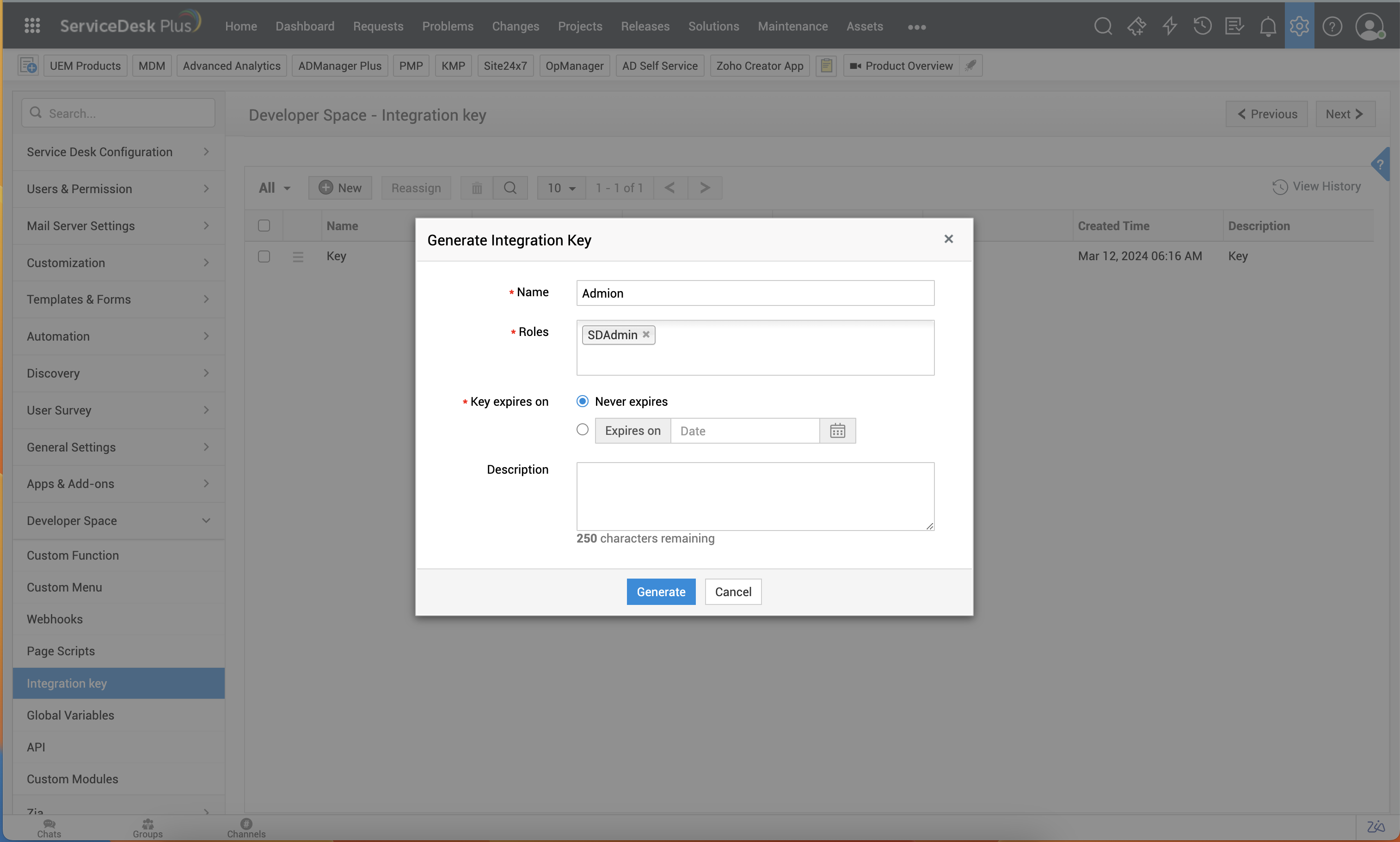Introduction
ManageEngine ServiceDesk Plus is a web-based, IT help desk software with integrated asset and project management built on an ITIL framework.
OpsRamp supports a one-way (outbound) integration.
OpsRamp Configuration
Install the Integration
- From All Clients, select a client.
- Go to Setup > Account.
- Select the Integrations and Apps tab.
- The Installed Integrations page, where all the installed applications are displayed. Note: If there are no installed applications, it will navigate to the Available Integrations and Apps page.
- Click + ADD on the Installed Integrations page. The Available Integrations and Apps page displays all the available applications along with the newly created application with the version.
- Search for ManageEngine ServiceDesk Plus using the search option available.
Note: Alternatively, you can use the All Categories option to search. - Click ADD on the ManageEngine ServiceDesk Plus tile. The Inbound tab is displayed.
Configure the Outbound Integration
Follow these steps to configure Outbound integration:
Configure the Outbound (From OpsRamp to ManageEngine ServiceDesk Plus)

To configure the outbound, follow these steps:
- Map Attributes: From the Map Attributes window, enter the below information:
- OpsRamp Entity: Select the OpsRamp entity from dropdown.
- OpsRamp Property: Select the OpsRamp property from dropdown. It will change based on entity selection.
- meservicedeskplus Entity: Enter the ServiceDesk entity.
- meservicedeskplus Property: Enter the ServiceDesk property.
- Click +Property Value in the Property Values section, and enter meservicedeskplus Property Value and OpsRamp Property Value and click Save.
Note:- The Property values section appears based on the OpsRamp Property selected.
- To add property values, click +Property Value.
- To map more attributes, click +Entity.
- Click Add Map Attributes .
- Events: Events are for sending notifications when an action is performed on OpsRamp entities.
- Click Add in the Events section.
- Enter a name for the event.
- Select the Entity, Entity Type, and Entity Type Event from the drop-down lists.
- (Optional) Under Advanced Settings, enter the values for Property, Operator, and Value and click Save.
- From Actions:
- (Optional) Select Use Parent Configuration checkbox to inherit parent configuration.
Example: - Enter the Endpoint URL.
Example:http://<servername>:<port number>/api/v3/requests/. - Select the Notification Type as REST API.
- Select the Authentication Type as None.
- Select the web method.
- (Optional) Select Use Parent Configuration checkbox to inherit parent configuration.
- Headers:
- Click +Add and enter/select the header name and value.
- Click Save to save the header name.
- (Optional) Click +Add to add more _headers
- Enter the Payload.
- Response:
- Click +Add and enter/select the response name and value.
- Click Save to save the response name.
- (Optional) Click +Add to add more _response
Note: The event is created, only if you provide the response properties.
- (Optional) Attachment: In the Attachment section, provide inputs in the Process Type, Attachment Endpoint URL, and Web Method fields.
- Attachment Headers: In the Attachment Headers section, provide inputs in the Name and Value fields and click Save.
- Enter the payload in the Attachment Payload box.
- Enter the Key and Value in the Attachment Response section.
- Click Add Event. The event is added.
There are some actions you can perform on the Events.
See here for more details.
Integration response mapping configuration
Response mapping configuration is mainly based on the response payload that is received in third party payload; below are a few examples for response mapping configuration:
- sample response payload to mapping the id in response mapping:
{ "id":"INC0001", "type":"incident", "tool":"servicedesk" }external ticket id = $id
We need to append $ to the value - sample response payload to mapping the id in response mapping:
{ "result":{ "id":"INC0001", "type":"incident", "tool":"servicedesk" } }external ticket id = $result.id
- Sample response payload to mapping the id in response mapping
{ "result":[ { "ticketDetails":{ "id":"INC0001", "type":"incident", "tool":"servicedesk" }, "Description":{ "display_value":"testing description", "value":"validating" } } ] }external ticket id = $result[0].ticketDetails.id
- sample response payload to mapping the Incident Number in response mapping
{ "result": { "Incident Number": "INC0001", "type": "Incident" } }external ticket id = $result[‘Incident Number’]
- Failures: In the case of failure in integration, an Email is sent to the user about the failure in integration.
To configure failure notification:- Click add from the Failures section.
- Select notification type as Email.
- Enter the email address(es) in the To and CC fields
- Click Add Failure Notifications. The details are added.
- Click Finish. The integration is installed.
Actions on Integration
You can perform actions on an integration.
- See here for more information.
Actions on Event
Follow these steps to perform actions on the events:
- Click on the integration name.
- Navigate to Outbound tab > Events section.
- Hover over the event name.
- Click the actions (three dots) menu. A popup appears with options.
- Copy Id: To copy an event Id.
- Edit: To edit the event details.
- Save as: To save an event name.
- Validate: Validate if the event is successful.
- Select Json or Form.
- Json: Enter the payload and click Validate.
- Form: Enter the property and value in the fields and click Validate.
A green tick appears if the event is successful
- Json: Enter the payload and click Validate.
- Select Json or Form.
- Remove: To remove an event.
Audit Logs
View logs from the Audit Logs tab. You can view if the event was successful or not.
Integration event payloads
Create Incident
| Field | Value | ||||
|---|---|---|---|---|---|
| Endpoint URL | http://<servername>:<port number>/api/v3/requests | ||||
| Notification Type | REST API | ||||
| Authentication | NONE | ||||
| Web Method | POST | ||||
| Headers |
Click the Add icon to add multiple values. | ||||
| Payload |
|
Request payload
{
"request": {
"subject": "Unable to fetch mails",
"description": "Unable to fetch mails from the mail server",
"requester": {
"name": "administrator"
},
"impact_details": "Tasks are pending"
}
}
Response:
{
"request": {
"ola_due_by_time": null,
"resolution": {
"resolution_attachments": [],
"content": null
},
"onhold_time": null,
"is_trashed": false,
"fr_sla_violated_group": null,
"id": "18",
"assigned_time": null,
"requester": {
"email_id": null,
"phone": "1234455",
"name": "administrator",
"mobile": "1234567890",
"profile_pic": {
"content-url": "/images/default-profile-pic2.svg"
},
"is_vipuser": false,
"id": "5",
"department": null
},
"cancel_requested_by": null,
"sla_violated_technician": null,
"item": null,
"has_resolution_attachments": false,
"impact": null,
"sla": null,
"priority": null,
"sla_violated_group": null,
"tags": [],
"has_notes": false,
"is_current_ola_violated": null,
"image_token": "f058d4bb03f0d3e5f6fded34057af6c97d78995a17032583dd27862de2fda7916133843ec290cfd17dea194c2a075e4aa6c3d5d3",
"status": {
"color": "#0066ff",
"name": "Open",
"id": "2"
},
"template": {
"is_service_template": false,
"service_category": null,
"name": "Default Request",
"id": "1"
},
"primary_asset": null,
"request_type": null,
"cancel_requested_time": null,
"chat_type": 0,
"is_service_request": false,
"cancel_requested": false,
"has_request_initiated_change": false,
"has_attachments": false,
"has_linked_requests": false,
"has_request_caused_by_change": false,
"has_problem": false,
"subject": "Unable to fetch mails",
"linked_to_request": null,
"mode": null,
"is_read": false,
"lifecycle": null,
"reason_for_cancel": null,
"assets": [],
"group": null,
"email_to": [],
"created_time": {
"display_value": "Mar 18, 2024 10:17 AM",
"value": "1710757038415"
},
"level": null,
"approval_status": null,
"service_category": null,
"created_by": {
"email_id": null,
"phone": "1234455",
"name": "administrator",
"mobile": "1234567890",
"profile_pic": {
"content-url": "/images/default-profile-pic2.svg"
},
"is_vipuser": false,
"id": "5",
"department": null
},
"scheduled_end_time": null,
"first_response_due_by_time": null,
"last_updated_time": null,
"impact_details": "Tasks are pending",
"subcategory": null,
"email_cc": [],
"scheduled_start_time": null,
"email_ids_to_notify": [],
"notification_status": null,
"description": "Unable to fetch mails from the mail server",
"has_dependency": false,
"has_conversation": false,
"fr_sla_violated_technician": null,
"callback_url": null,
"urgency": null,
"is_shared": false,
"request_template_task_ids": [],
"department": null,
"is_reopened": false,
"has_draft": false,
"is_overdue": false,
"technician": null,
"due_by_time": null,
"has_project": false,
"is_first_response_overdue": false,
"cancel_requested_is_pending": false,
"recommend_template": null,
"unreplied_count": null,
"category": null,
"maintenance": null
},
"response_status": {
"status_code": 2000,
"status": "success"
}
}
To map ManageEngine ServiceDesk Plus ticket ID with OpsRamp,
select EXT_ENTITY_ID from Response drop-down and enter the
$request.id value.
Update incident
| Field | Value | ||||
|---|---|---|---|---|---|
| Endpoint URL | http://<servername>:<port number>/api/v3/requests/$utils.extEntityId($incident.id,$installedAppId,$entity) | ||||
| Notification Type | REST API | ||||
| Authentication | NONE | ||||
| Web Method | PUT | ||||
| Headers |
| ||||
| Payload |
|
Request payload
{
"request": {
"subject": "Need an External Monitor",
"impact_details": "Details of the impact",
"description": "Provide me an External Monitor",
"priority": {
"name": "High"
}
}
}
Response:
{
"request": {
"ola_due_by_time": null,
"resolution": {
"resolution_attachments": [],
"content": null
},
"onhold_time": null,
"is_trashed": false,
"fr_sla_violated_group": null,
"id": "18",
"assigned_time": null,
"requester": {
"email_id": null,
"phone": "1234455",
"name": "administrator",
"mobile": "1234567890",
"profile_pic": {
"content-url": "/images/default-profile-pic2.svg"
},
"is_vipuser": false,
"id": "5",
"department": null
},
"cancel_requested_by": null,
"sla_violated_technician": null,
"item": null,
"has_resolution_attachments": false,
"impact": null,
"sla": {
"name": "High SLA",
"id": "4"
},
"priority": {
"color": "#ff0000",
"name": "High",
"id": "4"
},
"sla_violated_group": null,
"tags": [],
"has_notes": false,
"is_current_ola_violated": null,
"image_token": "1fd69830b17420ba341af26161af2c45f6b915d3a97e00beb0095416f72164ffa8bd25c229dbb1f15029dd3c37cc598fcfbaef6c",
"status": {
"color": "#0066ff",
"name": "Open",
"id": "2"
},
"template": {
"is_service_template": false,
"service_category": null,
"name": "Default Request",
"id": "1"
},
"primary_asset": null,
"request_type": null,
"cancel_requested_time": null,
"chat_type": 0,
"is_service_request": false,
"cancel_requested": false,
"has_request_initiated_change": false,
"has_attachments": false,
"has_linked_requests": false,
"has_request_caused_by_change": false,
"has_problem": false,
"subject": "Need an External Monitor",
"linked_to_request": null,
"mode": null,
"is_read": false,
"lifecycle": null,
"reason_for_cancel": null,
"assets": [],
"group": null,
"email_to": [],
"created_time": {
"display_value": "Mar 18, 2024 10:17 AM",
"value": "1710757038415"
},
"level": null,
"approval_status": null,
"service_category": null,
"created_by": {
"email_id": null,
"phone": "1234455",
"name": "administrator",
"mobile": "1234567890",
"profile_pic": {
"content-url": "/images/default-profile-pic2.svg"
},
"is_vipuser": false,
"id": "5",
"department": null
},
"scheduled_end_time": null,
"first_response_due_by_time": null,
"last_updated_time": {
"display_value": "Mar 18, 2024 10:23 AM",
"value": "1710757434369"
},
"impact_details": "Details of the impact",
"subcategory": null,
"email_cc": [],
"scheduled_start_time": null,
"email_ids_to_notify": [],
"notification_status": null,
"description": "Provide me an External Monitor",
"has_dependency": false,
"has_conversation": false,
"fr_sla_violated_technician": null,
"callback_url": null,
"urgency": null,
"is_shared": false,
"request_template_task_ids": [],
"department": null,
"is_reopened": false,
"has_draft": false,
"is_overdue": false,
"technician": null,
"due_by_time": {
"display_value": "Mar 18, 2024 11:17 AM",
"value": "1710760638415"
},
"has_project": false,
"is_first_response_overdue": false,
"cancel_requested_is_pending": false,
"recommend_template": null,
"unreplied_count": null,
"category": null,
"maintenance": null
},
"response_status": {
"status_code": 2000,
"status": "success"
}
}
To map the ManageEngine ServiceDesk Plus status property with OpsRamp,
select STATUS_MSG from the Response drop-down and enter the $response_status.status value.
Add response to incident
| Field | Value | ||||
|---|---|---|---|---|---|
| Endpoint URL | http://<servername>:<port number>/api/v3/requests/$utils.extEntityId($incident.id,$installedAppId,$entity)/notes | ||||
| Notification Type | REST API | ||||
| Authentication | NONE | ||||
| Web Method | POST | ||||
| Headers |
| ||||
| Payload |
|
Request payload
{
"note": {
"description": "Need info on this topic.",
"show_to_requester": true,
"mark_first_response": false,
"add_to_linked_requests": true
}
}
Response:
{
"note": {
"request": {
"subject": "Need an External Monitor",
"id": "18"
},
"last_updated_by": null,
"added_time": {
"display_value": "Mar 18, 2024 10:59 AM",
"value": "1710759585717"
},
"has_attachments": false,
"attachments": [],
"last_updated_time": null,
"added_by": {
"email_id": null,
"phone": "1234455",
"name": "administrator",
"mobile": "1234567890",
"profile_pic": {
"content-url": "/images/default-profile-pic2.svg"
},
"is_vipuser": false,
"id": "5",
"department": null
},
"image_token": "a55d58adbd4cddc167a3f0f7dd046ce1e1367e4d83c2a3399e6d163d3a3a3dabde1d51bb60f05737146153ab6420072a5c8c8f33",
"show_to_requester": true,
"description": "Need info on this topic.",
"id": "3"
},
"response_status": {
"status_code": 2000,
"status": "success"
}
}
To manage ManageEngine ServiceDesk Plus status property with OpsRamp,
select STATUS_MSG from Response drop-down and enter the $response_status.status value.
ManageEngine ServiceDesk Plus Configuration
Configuration involves generating an authentication key. The authentication key (technician key) is required to post OpsRamp events as ServiceDesk Plus Incidents using ServiceDesk Plus APIs.
To generate an authentication key in ServiceDesk Plus:
- Log into ServiceDesk Plus with administrator privileges.
- Navigate to Admin > Developers Space > Integration key.

- Click Add New to add a new technician and configure the following:
- Enter name.
- Enter a description and specify the privileges for the technician.
- Select Enable login for this technician and enter information for the technician.
- Select Enable Administrator Privileges (SDAdmin).
- In API key details, click Generate/Regenerate and select Never Expires to generate the authentication key.
- Copy the authentication key. The key is used while configuring an integration event in OpsRamp.
Or, you can generate an authentication token for an existing user by editing the technician details using API key details > Generate.

